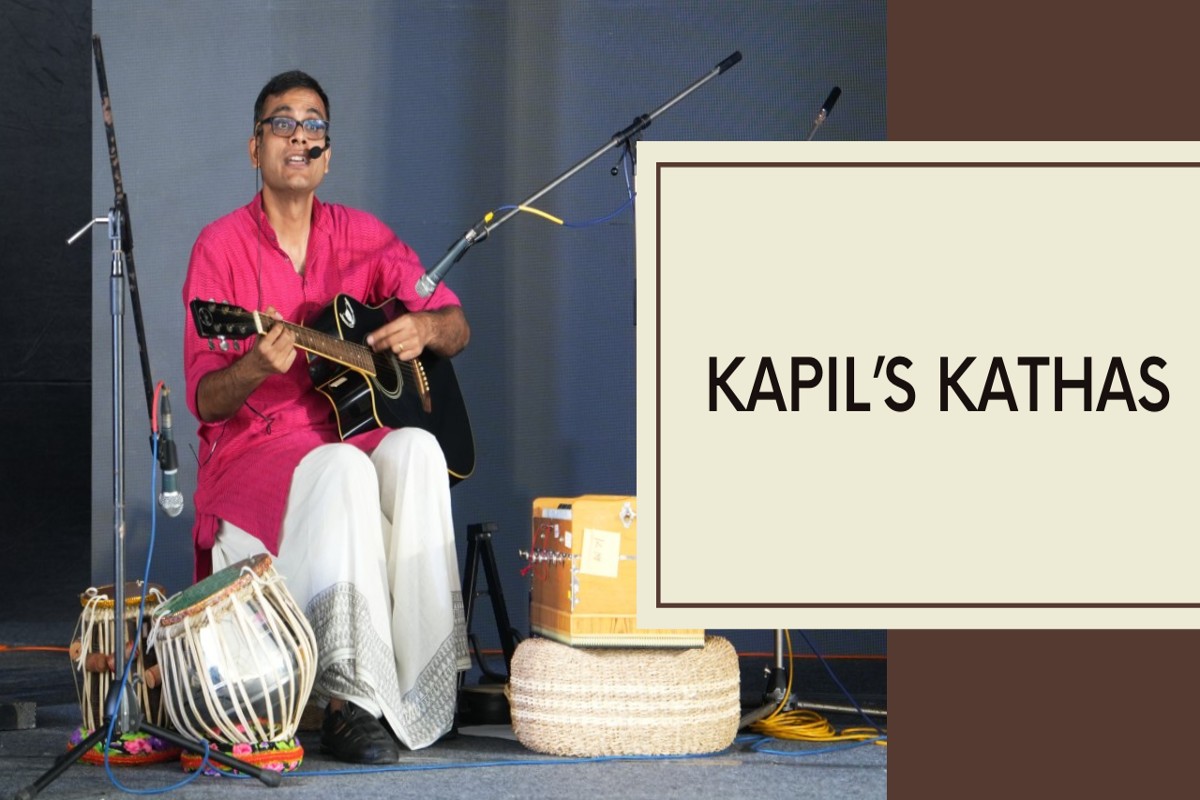By Jyothsana Narasimhan, Educator
The world of performance art and vocal poetry is a creative and expressive realm where the artists are the conduits of innovation and engagement. Kapil Pandey is one such name that has been making waves in the contemporary art scene, and at many a Neev Literature Festival galore! His unique and captivating form of visual storytelling continues to enthrall the audience at NLF year after year.
His opening performance on Day 1 of NLF 2023, titled A Tale of the Missing Barbers, was an expressive bilingual performance in Hindi and English narrating in verse the tale of a barber and the demands of his client, and it went something like this –
“धाड़ी बना दे
मूछ सजा दे
बाल काट दे
मालिश कर दे
चंपी कर दे
चैंपू कर दे
रगड़ रगड़ के
चपड़ चपड़ के”
Kapil goes on to bring to life the case of the missing barbers through intonations and vocal inflections, infusing the ancient oral tradition of storytelling with contemporary themes and experiences, as well as with the lyrical qualities of the nation’s most widely spoken language – Hindi. The poet explores the sounds, cadences, and possible layers and wordplays in the language through his myriad performances, creating with his words room for interpretation. For instance, though the above text appears to be describing a routine for grooming and personal care, in the context of salon services, Kapil brings to light the multiple interpretations of the words “Hajam” and “hajamat” in Hindi and Urdu. Hajam (हजम in Hindi) typically refers to the person who shaves or grooms another person, often a professional barber or shaver. Hajamat refers to the act of shaving or grooming. Kapil then adds a regional Lucknowi twist to the use of “Hajamat” wherein it no longer refers to personal grooming but rather a good chiding or a reprimand for a mischief with this turn of the phrase, “अब तुम्हारी हजामत करते हैं!” – “Now, you shall be duly admonished!”
Kapil’s closing performance on Day 1, Ganga’s Curse, was equally captivating. The performance narrating the story of Durvasa’s curse, the theft of the sacrificial horse, and Ganga’s descent to Earth, highlighted the significance of penance and devotion, and the psyche behind the holiness and sanctity attributed to the river Ganga in Hindu mythology, and the cultural practices associated with it. Here’s a short recap of the mythological story as narrated by Kapil.
One day, King Sagar of Ayodhya was conducting the Ashwamedha Yagna (a grand horse sacrifice). As a part of the ritual, a sacred horse was allowed to roam freely, and it was to be unchallenged. King Sagar’s 60,000 sons were tasked with guarding the horse. However, during their watch, the horse was stolen by Lord Indra, the king of the heavens. Believing that Sage Kapila had taken the horse, King Sagar’s sons confronted him. In response, Kapila opened his eyes, and the sons were reduced to ashes due to the sage’s fiery gaze. However, it was Lord Indra who had taken the horse. King Sagar’s grandson, Anshuman, later sought Sage Kapila’s advice on how to free his ancestors’ souls.
Sage Kapila explained to Anshuman that only the holy river Ganga could absolve the sins of his ancestors. King Bhagirath, another descendant of King Sagar, took up this quest. He performed severe penance and austerities to please Lord Brahma, the creator. Lord Brahm
a, pleased with Bhagirath’s devotion, granted him a boon. Bhagirath requested that Ganga descend from the heavens to Earth to cleanse the ashes of his ancestors. Lord Brahma agreed but cautioned that Ganga’s descent to Earth would be so forceful that it could wreak havoc if not controlled. Bhagirath then prayed to Lord Shiva, who agreed to break Ganga’s fall by letting her flow through his matted hair. This act of Lord Shiva is often depicted in art and is known as Ganga Avataran, or the descent of the Ganges. As Ganga flowed through Lord Shiva’s hair and descended to Earth, she became a sacred river that flowed through the land of India.
Through these and other performances, such as Us vs Them, Spinning Dreams, and Spring Stretches to name a few, Kapil encouraged the audience to dwell upon themes ranging from nature, relationships, values, mythology and identity, to social issues, politics, philosophy, climate change and much more, ensuring that his performances had something everyone could connect to.
Kapil’s interactive art form engaged the audience, eliciting reactions, emotions, and often inviting reflection on the themes he put forth, building a strong sense of community. It also served as a medium for social and political commentary, addressing issues such as inequality, injustice, discrimination, and the complexities of modern life in India, and our role as global citizens of the world. His pieces captured the complexities of the human psyche, offering viewers a glimpse into a spectrum of feelings, moving from joy and elation to introspection through humor. His innovative approach to performance has inspired aspiring artists to break free from traditional constraints and embrace the limitless possibilities of creative expression.
Kapil Pandey’s work transcends conventional artistic boundaries, and as we look back upon his performances through the many years of NLF, we are reminded that art has the power to inspire, connect, and transform, and Kapil’s work exemplifies this transformative potential!





